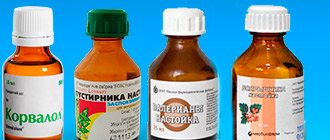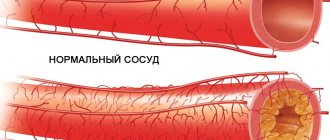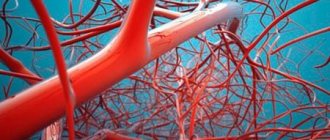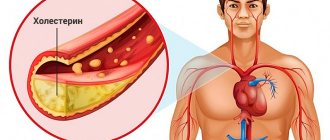Excessive consumption of foods with a high concentration of animal fats, genetic predisposition, age and many other factors lead to disturbances in cholesterol metabolism and the formation of atherosclerotic plaques in any part of the vascular bed.
This condition is very dangerous due to the possibility of developing serious complications: from coronary heart disease to stroke or myocardial infarction.
There are many folk remedies described on the Internet for cleaning blood vessels, but not all of them are effective. Before starting therapy, you should consult your doctor.
What are cholesterol plaques
Each human organ receives nutrition from vessels, of which there is a huge and extensive network in the body. Blood flowing through the vessels is not a solution, but a suspension, when a suspension of cells, called formed elements, floats in the liquid. The liquid part of the blood does not at all resemble water, which is explained by the molecules dissolved in it, mainly of a protein nature. But various products of fat metabolism also “float” in the blood, in particular cholesterol, triglycerides, and lipoproteins.
According to the laws of physics, blood moves through the vessels in such a way that it is practically free of cells, and most of the formed elements “go” along the edges, representing a kind of “quick response department”: in response to damage to the vessels, platelets immediately descend from here, “closing” gap.
The liquid part of the blood also comes into contact with the vascular walls. As we remember, the products of fat metabolism are dissolved in it. There are several different ones, cholesterol is only one of the components. This system is structured as follows: normally, “bad” fats are in balance with their antagonists, “good” fats (“good” cholesterol). When this balance is disturbed - either the number of “bad” ones increases, or the volume of “good” ones decreases - fatty tubercles - plaques - begin to be deposited on the walls of arterial vessels. The risk of depositing such plaques is judged by the ratio of good fats (they are called “high-density lipoproteins” - HDL) and the sum of low-density lipoproteins (LDL) and very low-density lipoproteins (VLDL). This can be done using a blood test from a vein, called a lipid profile.
Such a plaque is dangerous in the following ways:
- It can come off and, having passed with the blood flow to a vessel of “suitable” diameter, clogs it, thereby depriving the area feeding from there of some kind of nutritional organ. The smaller the vessel, the smaller the area that dies, the less the functioning of this organ and the body as a whole is disrupted (there is “duplication” within the tissue of each organ, thanks to which each “piece” receives nutrition from several small-diameter vessels at once).
- The blood is forced to bypass the plaque, as a result of which, instead of a uniform flow in the vessel, “vortices” are created when part of the blood flowing near the wall covered with the plaque has to return back. Turbulence in the blood flow impairs the nutrition of the blood supply to the organ. Here the relationship is the same as in the point above: the larger the diameter of the artery damaged by the plaque, the more the organ suffers.
- If the composition of the blood does not change, and the amount of HDL and enzymes that should “break off” the plaque does not increase, the body tries to limit it. To do this, he sends immune cells to the site of plaque deposition, whose task is to “bite off” pieces of the plaque and digest them. But the cells are unable to do this: instead of digesting, the immune cells are damaged by cholesterol and fats, and remain “lying” around the cholesterol. Then the body decides to cover this formation with connective tissue, and the plaque increases in size even more, now worsening the blood supply to the organ not only due to turbulence, but due to a decrease in the lumen of the vessel.
- Covering with connective tissue is good for the plaque and bad for the vessel. Now, if something damages the plaque, it will “call” platelets to itself, which will form a blood clot on its surface. This phenomenon, firstly, will further reduce the diameter of the vessel, and secondly, it will increase the risk (especially in vessels with “active” blood flow) of a blood clot breaking off and blocking a smaller vessel.
- A long-existing plaque becomes covered with calcium salts. Such a wall formation is already stable and will not come off without intervention. But it tends to grow and reduce the lumen of the vessel.
The rate of plaque formation is affected by:
- consumption of animal fats;
- smoking;
- diabetes;
- excess weight;
- physical inactivity;
- high blood pressure;
- binge eating;
- eating large amounts of simple carbohydrates with food.
The localization of plaque deposition is unpredictable: it can be either the arteries supplying the brain or the arteries of the kidneys, limbs or other organs. Depending on this, they can cause:
- ischemic stroke;
- angina pectoris;
- myocardial infarction;
- intestinal gangrene;
- aortic aneurysm;
- discirculatory encephalopathy, which is manifested by memory deterioration, headaches, decreased ability to analyze what is happening;
- deterioration of blood supply to a larger or smaller area of the limb, up to its gangrene;
- if the plaque blocks the aorta in the area where large vessels originate from it to each of the lower extremities, both legs will suffer only from ischemia or gangrene.
Correction of lifestyle and diet
According to national recommendations for doctors, the following conditions must be met:
- Loss of body weight. Overweight is considered to be a BMI of more than 25 kg/m2. Waist size is also an important criterion for abdominal obesity: in men the norm is up to 94 cm, in women – up to 80 cm. Reducing body weight through a number of indirect mechanisms allows not only to reduce cholesterol levels, but also to reduce the severity of other components of the metabolic syndrome (lower blood pressure and blood glucose concentrations).
- Regular physical activity. It is necessary to devote at least 30 minutes 5-7 days a week to aerobic exercise (running, cycling or exercise bike, swimming). It has been proven that regular exercise can increase the level of high-density lipoprotein (“good” cholesterol) and reduce the number of triacylglycerides.
- Quitting alcohol and smoking. Consumption of drinks containing ethanol is directly proportional to the concentration of triacylglycerides in the blood. Patients with any signs of pathology in the lipid profile, especially with elevated TAG, should abstain from alcohol altogether. Smoking is a major risk factor for atherosclerotic damage to important arteries in the body (even in the absence of signs of dyslipidemia) and the subsequent development of extremely dangerous complications (coronary artery disease and myocardial infarction).
- Diet correction. It is necessary to reduce the consumption of total fats to 25% of the total calorie content of food eaten. The number of carbohydrates is within 50%, the rest is proteins. You should also limit your salt intake to 3 g per day.
For clarity, the main recommendations regarding diet are presented in table form.
| Types of products | Preferably | Acceptable | Unacceptable |
| Cereals | Whole varieties. | Rice and pasta, corn flakes. | Delicious baked goods. |
| Vegetables | Raw, not heat treated. | Potatoes in any form. | Vegetables with butter or cream. |
| Fruits | Any, fresh or frozen. | Dried fruits, jams, canned foods, juices. | |
| Legumes | Peas, beans, beans, soybeans. | ||
| Meat and fish | Fish is fatty. Meat – without bones, cartilage, tendons and skin. | Lenten tenderloins, crustaceans. | Sausage, salt, bacon, offal (liver products). |
| Fermented milk products and eggs | Yogurts, low fat milk. | Milk of any fat content, cheese, eggs. | Cream. |
| Seasonings | Mustard, vinegar (homemade and industrial), other low-fat seasonings. | Olive oil, ketchup, mayonnaise. | Margarine, lard, butter, trans fats. |
| Cooking method | For a couple. | Roasting. | Frying in oil. |
How to determine if there are cholesterol plaques
Before cleaning blood vessels from cholesterol plaques and blood clots, you need to find out whether they are there or not. If the lipid profile shows the risk of plaque formation, the coagulogram shows the risk of thrombus formation, then instrumental studies will help to detect immediate “congestion” in the vessels:
- A special type of ultrasound is color duplex scanning. In this way it is very convenient to examine the arterial and venous vessels of the upper and lower extremities, the aorta, vessels going to the brain and those that nourish the retina;
- Triplex scanning is another option for ultrasound. It is used to examine the vessels of the brain and the arteries that supply it - those located outside the cranial cavity;
- The most accurate research method is angiography. It is used to clarify the location of plaques/thrombi in the vessels of the extremities that were identified during duplex or triplex scanning, as well as to determine blood clots/plaques in those organs that cannot be seen during ultrasound examination.
Interesting Facts
World-famous cyclist Lance Armstrong was diagnosed in 1996 with an advanced form of testicular cancer with metastases to the lungs, abdomen and brain. Many experts believed that he was incurable; he was given only a 20% chance of survival. After a series of operations and many courses of aggressive therapy, Armstrong finally survived. In addition, in 1998, Lance took 4th place in the prestigious multi-day cycling race.
After his recovery, Armstrong created an anti-cancer movement and a foundation to fight cancer. In 2000, the cyclist published his book “My Return to Life.” Lance is still alive and well.
When to clean vessels
You need to clear cholesterol from your blood vessels when:
- According to instrumental methods, atherosclerotic plaques were detected or
- when there is already a violation of internal organs, against the background of which a high atherogenic index is detected (according to lipid profile). These are: cholesterol above 6.19 mmol/l;
- LDL – more than 4.12 mmol/l;
- HDL: below 1.04 for men, below 1.29 mmol/l for women.
In the following cases, it is necessary to do everything possible to prevent the deposition of cholesterol on the walls of blood vessels:
- men over 40 years old;
- women over 55 years old;
- if you have bad habits;
- if a person eats a lot of smoked, fried, salty food, meat;
- if relatives have atherosclerosis, ischemic or hypertension;
- suffering from diabetes mellitus;
- those who note the presence of excess weight;
- those who have suffered a complication of streptococcal infections such as rheumatism;
- if at least once there was numbness of one limb or half of the body, which did not follow their compression, but arose “by itself”;
- if at least once there was a visual impairment in one eye, which then went away;
- when there was an attack of sudden general weakness;
- if there is causeless pain in the navel area, accompanied by flatulence and constipation;
- when memory deteriorates, and the desire to rest causes less and less mental stress;
- if it becomes more and more difficult to walk, your legs hurt with less and less load;
- when there is chest or cardiac pain that is not relieved by nitroglycerin;
- if the hair on your legs falls out, and your legs themselves turn pale and freeze;
- if any ulcers, redness, or swelling begin to appear on the lower extremities.
Treatment of atherosclerosis with onions and garlic. Garlic recipes.
Unsurpassed means for a person, the well-being of his body. Onions and garlic can be eaten daily, without restrictions, receiving only benefits.
And
You can prepare a special tincture from onions and vodka.
For half a liter of vodka:
- 3 kg onions
- half a kilo of honey
- 25 partitions made of walnuts.
Squeeze off the onion juice and mix with honey. Partitions fall out. All this is filled with vodka. Infuses for 10 days. After this, the resulting product is taken one tablespoon 2-3 times a day. The medicine can cure hypertension, bring blood vessels and capillaries into optimal condition, activate and normalize blood flow, and prevent spasms.
Garlic is also a recognized fighter against atherosclerosis. There are an endless number of recipes with garlic. High antioxidant activity, phytoncides cleanse the blood, increase the elasticity of blood vessels, and gradually remove plaque from the walls.
The simplest recipe - effective and fast.
On an empty stomach, eat a piece of bread with butter, sprinkled with finely chopped garlic. This course can be taken daily, there are no contraindications, no side effects.
Garlic healing vodka. Finely chop 100 g of garlic and pour 2 cups of vodka. Leave at room temperature, protected from light, for 3 days. During this time, shake several times. Drink 5 drops three times a day some time before meals.
Dry wine tincture. Grind the garlic (1 head), finely chop the wormwood leaves (to make 3 tablespoons of raw materials). Heat dry wine (700 ml so that it is hot) in a water bath. Red or white will do, depending on your taste.
Leave for 5 days in the dark, then strain, squeezing out the raw materials.
Take 2 tablespoons three times daily, before meals.
For those who don't want alcohol. Pour olive oil (3/4 cup) over the crushed head of garlic. Keep the mixture tightly closed and shake regularly. Drink a teaspoon daily, preferably on an empty stomach or before meals. Use the prepared volume within 3 months. This remedy is good for tachycardia.
Onion peel
There are always raw materials for cooking. The product, prepared according to any of the existing recipes, restores blood flow throughout the entire circulatory system, including capillaries.
An unusual recipe that normalizes blood pressure, cleanses blood vessels and supports heart failure.
Chop 5 tablespoons of pine needles, mix with 2 tablespoons of ground husks and 2 tablespoons of dry ground rose hip petals. Pour boiling water (500 ml), cook for 5 minutes. Then leave at room temperature for 6 hours. Drink a third of a glass after each meal, up to 4 times a day. Take courses for 2-3 weeks.
How to clean blood vessels from atherosclerotic plaques
The program for cleaning blood vessels from cholesterol deposits on their walls should be carried out by a doctor based on the results of laboratory and instrumental studies. It must include:
- lifestyle changes if they lead to the formation of plaques;
- adherence to a diet that will lead to the normalization of the functioning of the digestive organs, so that “good” cholesterol is best absorbed;
- a diet that will prevent blood clots.
According to indications, the following may be prescribed:
- medications that reduce blood cholesterol levels;
- drugs that reduce blood viscosity;
- folk remedies aimed at normalizing blood viscosity or reducing cholesterol levels.
How to achieve the release of hormones into the blood
To ensure that hormones enter the blood regularly, you should exercise. Hormones will not enter the bloodstream only as a result of physical stress. A factor such as psycho-emotional state plays a role here. Such a system is yoga - a set of static exercises designed to alternately tense and relax all muscles and tendons in a trained awareness of the unified movement of the body and soul.
Also recently, a complex developed by Russian specialists, Isoton, has been gaining popularity. The author of the idea and the main developer is V.N. Seluyanov. Athletes who trained using Isoton showed good results - this proves the effectiveness of the complex.
The developers managed to create the possibility of a complex effect on the body. Everyone who practiced Isoton noted:
- increased performance
- wellness
- health promotion
- improvement of appearance.
The exercises are performed in a state of prolonged muscle tension - thus achieving an emotional state of mild stress. The tension is maintained as much as possible. Performing exercises in this mode very quickly tones the muscles and restores the functionality of blood vessels.
The system includes several techniques aimed at different goals. Initial, basic, strength, healing, relaxing.
The goal of each technique is to have a beneficial effect on the body:
- during training, the respiratory organs are developed and cleansed, breathing becomes easier and deeper
- the pressure does not increase
- muscle-nervous connections are restored
- fat is gradually replaced by muscle tissue
- immunity and adaptive system of the body increases.
The system provides training to reduce fat mass in certain areas of the body. This happens simultaneously with the development of endurance, the ability to achieve a harmonious state of body and soul.
You can train with Isoton without age restrictions. Training is suspended during acute periods of chronic diseases.
It is better to start mastering the techniques with exercises that affect local areas of the body. Cleansing blood vessels through physical activity will simultaneously solve the problems of excess weight, pain in the back, arms and legs.
Symptoms
Signs of atherosclerosis do not appear immediately. The first stages of atherosclerosis of the heart vessels are asymptomatic. The disease makes itself felt when the coronary artery becomes so blocked that it no longer supplies the heart with enough blood. A blood clot can completely block blood flow, causing a heart attack.
The main sign of severe atherosclerosis is burning or pressing pain in the chest, which initially bothers you during physical activity or in a stressful situation. This syndrome is called cardiac angina. Pain can be felt behind the sternum, radiating to the left arm, shoulder girdle and jaw. In addition to the feeling of constriction, a person is worried about shortness of breath, weakness, and excessive sweating. All these are signs of coronary heart disease (CHD). The nature of the load under which attacks occur varies. At later stages of development of coronary artery disease, the pain syndrome is no longer determined by any reasons; in this case, they speak of a type of angina called resting angina.
Contraindications to the use of absorbable agents
Obstacles to the use of vascular cleansing products may include:
- gastrointestinal diseases
- pregnancy
- lactation.
If you select products from natural gifts, you should remember that many of them are irritating due to their high content of vitamins and microelements and can cause allergic reactions. Plus it requires a relatively normal stomach and intestines.
Fruits and berries increase sugar. Herbs also need to be selected carefully, taking into account your condition.
Taking pills also has a downside. Some act on the liver, others can cause bleeding. Therefore, it is better to entrust the selection of medications and supplements in case of poor health to a doctor.
Complications caused by atherosclerosis
With deformation, blockage of blood vessels, and disruption of the blood supply to tissues, the following most often develop:
- Trophic ulcers of the feet and legs. When blood flow is impaired, local immunity decreases, the skin loses its ability to regenerate, and inflammatory processes begin. They are difficult to treat and have a long course. Chronic inflammation causes tissue necrosis. Open wounds appear on the skin, prone to constant relapses.
- Gangrene of the legs. Blockage of arteries with plaques, vasospasm during atherosclerosis often causes cessation of blood circulation in the arteries of the lower extremities. Next, tissue necrosis occurs with a change in color from dark brown to black. Consequences: limb amputation.
- Myocardial infarction. Ischemic necrosis of the heart muscle, 98% of cases occurs due to damage to the aorta by plaques.
- Stroke. When the cerebral arteries in the brain become narrowed or blocked, blood flow decreases. An acute vascular accident causes irreversible tissue changes, as a result of which serious neurological disorders develop. Consequences: disability, death.
- Organ ischemia. Cholesterol plaques can damage any vessel and reduce blood flow. The result of insufficient blood supply is temporary failure of functions or permanent damage to organs: intestines, kidneys, lungs, liver.
Atherosclerotic plaques can form in different arteries at the same time. But most often the large vessels of the heart and brain are affected.
Surgery
If there is significant damage to the arteries of the heart, the doctor prescribes surgery. Interventions are performed as planned, and in acute coronary insufficiency and in the early stages of a heart attack, emergency surgery helps save lives.
Bypass surgery is an open operation that is performed using a synthetic prosthesis or other vessel that will allow blood flow to bypass the affected area.
Coronary angioplasty and stenting is an endovascular intervention that is performed under local anesthesia without incisions. The operation is minimally traumatic for the patient. The doctor inserts the first catheter through a puncture in a vessel of the leg or arm into the artery with an atherosclerotic plaque, and inserts the second, with a balloon at the end, into the narrowing of the coronary artery. The catheter with the balloon inflates and leads to an increase in the lumen. The surgeon installs a stent in the narrowed segment, which will maintain the artery in an open state.










